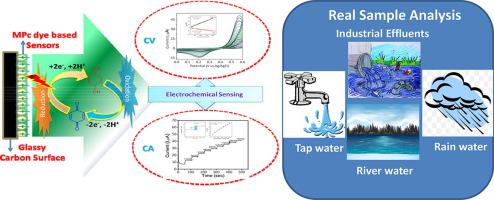Journal of Electroanalytical Chemistry ( IF 4.5 ) Pub Date : 2021-09-01 , DOI: 10.1016/j.jelechem.2021.115657 Manjunatha Nemakal 1 , Giddaerappa 1 , Shantharaja 1 , Veeresh A. Sajjan 1 , Lokesh Koodlur Sannegowda 1

|
Analogs of amide bridge cobalt phthalocyanine complexes with different peripheral substituents have been prepared with good yield and these dyes possess dark green colour. These phthalocyanine complexes are characterized by elemental analysis, absorption spectra, infrared spectroscopy, mass and electrochemical methods. An attempt has been made to understand the structure–property relationship of these molecules for electrochemical properties. Hence, uniform and thin film of amide phthalocyanine (Pc) complex was administered on glassy carbon electrode (GCE) surface and scanning electron microscopy (SEM) images displayed the uniform distribution of the macrocycle on the surface. The modified electrodes are found to be electroactive and the Ohmic/Faradic surface response of the film is studied using electrochemical impedance spectroscopy (EIS). The formal Co(II)/(I) redox behavior of the substituted phthalocyanines have been explained using Hammett parameter. The electrode surface modified with terminal amide bridged Co-N4 macrocyclic complexes were applied for the sensing of hydroquinone (QH2). An attempt was made to understand the influence of structure and functional groups on the electrocatalytic activity. Cyclic voltammetry (CV) displayed significantly increasing current trend for QH2 in the quantitative range 200–2200 nM at the furan containing amide phthalocyanine (CoTAMFCAPc) electrode with a low limit of detection (LOD) of 65 nM. Further, the chronoamperometric analysis showed better linear response for QH2 in 170–1530 nM range with LOD 56 nM at GCE/CoTAMFCAPc electrode compared to other molecules. The fabricated GCE/CoTAMFCAPc electrode demonstrated good stability and selectivity for QH2 in presence of molecules with similar structure which co-exist along with QH2. GCE/CoTAMFCAPc electrode can be employed for practical application and produced superior recovery values for QH2.
中文翻译:

新型酰胺偶联酞菁:氢醌电催化和传感的合成和结构特性关系
具有不同外围取代基的酰胺桥钴酞菁配合物的类似物已以良好的产率制备,这些染料具有深绿色。这些酞菁配合物的特征在于元素分析、吸收光谱、红外光谱、质量和电化学方法。已经尝试了解这些分子的结构-性能关系以实现电化学性能。因此,酰胺酞菁(Pc) 复合物施用于玻璃碳电极 (GCE) 表面,扫描电子显微镜 (SEM) 图像显示大环在表面上的均匀分布。发现改性电极具有电活性,并且使用电化学阻抗谱 (EIS) 研究了薄膜的欧姆/法拉第表面响应。取代的酞菁的形式 Co(II)/(I) 氧化还原行为已使用哈米特参数进行了解释。用末端酰胺桥接的 Co-N4 大环配合物修饰的电极表面用于检测对苯二酚 (QH 2 )。试图了解结构和官能团对电催化活性的影响。循环伏安法 (CV) 显示 QH 2 的电流趋势显着增加在含呋喃酰胺酞菁 (CoTAMFCAPc) 电极的定量范围为 200–2200 nM,检测下限 (LOD) 为 65 nM。此外,计时电流分析显示,与其他分子相比,在 GCE/CoTAMFCAPc 电极上,QH 2在 170-1530 nM 范围内具有更好的线性响应,LOD 为 56 nM。制造的GCE/CoTAMFCAPc电极在与QH 2共存的具有相似结构的分子存在的情况下对QH 2表现出良好的稳定性和选择性。GCE/CoTAMFCAPc 电极可用于实际应用,并为 QH 2产生优异的回收率值。



























 京公网安备 11010802027423号
京公网安备 11010802027423号